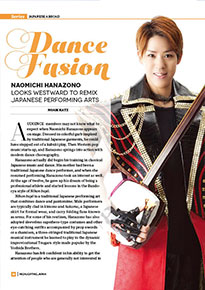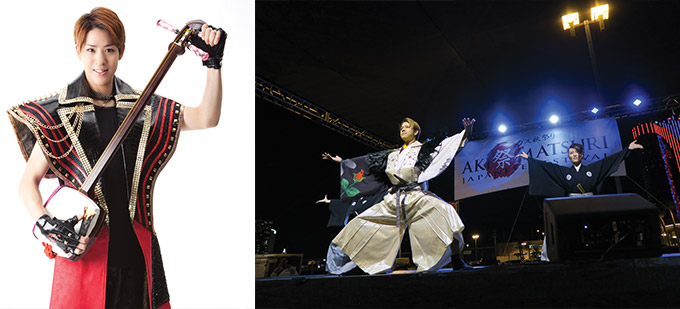Home > Highlighting JAPAN >Highlighting Japan December 2014> Japanese Abroad
Highlighting JAPAN

Japanese Abroad
Dance Fusion
Naomichi Hanazono Looks Westward
to Remix Japanese Performing Arts

Audience members may not know what to expect when Naomichi Hanazono appears on stage. Dressed in colorful garb inspired by traditional Japanese garments, he could have stepped out of a kabuki play. Then Western pop music starts up, and Hanazono springs into action with modern dance choreography.
Hanazono actually did begin his training in classical Japanese music and dance. His mother had been a traditional Japanese dance performer, and when she resumed performing Hanazono took an interest as well. At the age of twelve, he gave up his dream of being a professional athlete and started lessons in the Bando-ryu style of Nihon buyō.
Nihon buyō is a traditional Japanese performing art that combines dance and pantomime. Male performers are typically clad in kimono and hakama, a Japanese skirt for formal wear, and carry folding fans known as sensu. For some of his routines, Hanazono has also adopted sleeveless superhero-type costumes and other eye-catching outfits accompanied by prop swords or a shamisen, a three-stringed traditional Japanese musical instrument he learned to play in the dynamic improvisational Tsugaru style made popular by the Yoshida Brothers.
Hanazono has felt confident in his ability to get the attention of people who are generally not interested in traditional dance since his early student days. His first performances were as a junior high school student at small local saunas or spas. “Sometimes there were just five or six guys lounging around indifferently,” he recalls, “but by the end they would be looking in my direction.”
While Hanazono has observed some resistance to his performance style in Japan, where audiences appear to have more fixed expectations about Japanese dance, he has found that other foreign audiences, particularly in Korea and the United States, are openly receptive to his new style. “Many people tell me how cool my performance was,” he says with a smile.
One of Hanazono’s crowd-pleasing techniques is to incorporate Western music into his routines, and U.S. audiences rave when he performs dance moves to Michael Jackson’s “Dangerous” and Lady Gaga’s “Judas.” In the same way that Jackson used his black fedora for flair, Hanazono achieves a similar effect by spinning, throwing and catching his sensu. Yet he never lets spectators forget his background in Japanese classical arts, such as when he ended a recent performance in Los Angeles by kneeling in traditional seiza style and bowing low. “The audience went wild and gave me a standing ovation,” he says.
Hanazono believes that Japanese dance can offer something new to Western audiences who are only familiar with established dance genres such as ballroom, jazz and hip-hop. The distinction lies in Japanese music’s use of ma, or pauses. “In Nihon buyō, we don’t have a count of 1-2-3-4-5-6-7-8,” he notes. “We have to sense the overall mood, and appreciate intervals in the music. I think this sense of timing is unique to Japan.”
Now twenty-six, Hanazono says he is still learning and improving. “When I look back at video of dances I’ve done, I realize how much I could have done better.” Hanazono intends to keep refining his technique, and also sees potential in incorporating Japan’s latest stage technology and computer graphics into his show.
Both at home and abroad, Naomichi Hanazono is challenging conventional notions of dance and giving his audience a new perspective on Japanese culture.
© 2009 Cabinet Office, Government of Japan






